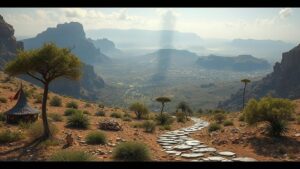Investigating the use of the “Coso Artifact,” a spark plug-like object found in ancient rock.
Investigating the Coso Artifact: A Spark Plug-like Object Found in Ancient Rock
The Coso Artifact is a peculiar and controversial object that was discovered in 1961 by a group of amateur archaeologists in the Coso Mountains of California. This object, resembling a spark plug, has sparked intense debate and intrigue because of its unusual appearance and implications for our understanding of ancient technology. This article explores the background, characteristics, and significance of the Coso Artifact while addressing the questions that arise from its existence.
Historical Context of the Coso Artifact
The Coso Artifact was uncovered during a mining operation in the eastern Sierra Nevada region of California. Approximately 500,000 to 1 million years old, the artifact was embedded in a layer of volcanic rock. Its discovery drew immediate attention from archaeologists and enthusiasts because its design suggests a functionality not typically associated with ancient tools. This raises questions about the technological capabilities of ancient civilizations.
Characteristics of the Coso Artifact
The object measures about four inches in length and resembles a modern spark plug, complete with a central electrode and ceramic insulator. Experts have noted the following key features:
- The intricate design, which includes threads and metallic components, indicates precision engineering.
- The composition of the artifact has been analyzed and found to contain materials common in modern manufacturing, including a combination of metals and ceramics.
Despite its spark plug-like appearance, some researchers argue that it could simply be a natural geological formation, a product of natural processes mimicking man-made objects. But, this argument does not fully address the complexity and sophistication evident in the design.
Scientific Investigations and Controversies
The scientific community has conducted multiple studies on the Coso Artifact. In 1973, a team led by geologist and engineer Dr. Robert M. A. Hurst concluded that the object is not a modern fabrication but rather a genuine item from the ancient past. methodology employed included:
- X-ray diffraction to analyze the mineral composition.
- Comparative analysis with known geological formations.
But, the findings of Dr. Hursts team have been met with skepticism. Critics argue that the artifact could be evidence of “pseudoscience†or misinterpretation of data. In particular, the phenomenon of pareidolia, where the human mind perceives familiar shapes in random structures, has been cited as a potential explanation. This controversy highlights the divide between mainstream archaeology and alternative theories regarding ancient technologies.
Implications for Understanding Ancient Technology
If the Coso Artifact is indeed a product of ancient craftsmanship, its implications for our understanding of human history could be profound. Consider the following points:
- A reconceptualization of technological development timelines: If advanced tools existed earlier than typically believed, it could shift our understanding of human ingenuity.
- Challenging the established narrative of human evolution and technology: Evidence of complex technology could suggest interactions between ancient civilizations and their environments that were previously unrecognized.
Real-World Applications and Takeaways
The ongoing debate surrounding the Coso Artifact serves as a critical reminder of the need for an open yet skeptical inquiry into our past. It emphasizes the importance of scientific rigor in archaeology while also allowing space for new ideas and interpretations. For enthusiasts and researchers alike, the Coso Artifact highlights several actionable takeaways:
- Conduct further interdisciplinary studies: Combining archeology, geology, and engineering can lead to new insights.
- Encourage public discourse: Open discussions can foster greater interest and investment in archaeological finds.
Ultimately, whether the Coso Artifact is a genuine remnant of an ancient civilization or a natural geological oddity, it serves as a catalyst for investigation and exploration into the capabilities of our ancestors.



